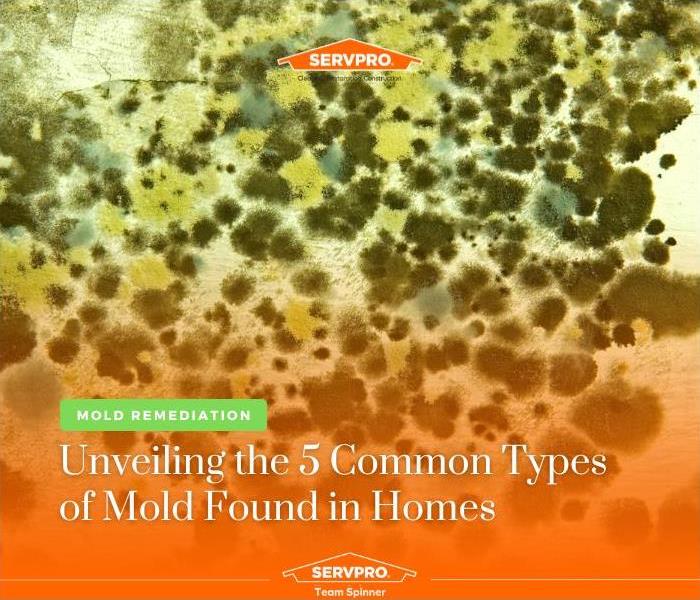Unveiling the 5 Common Types of Mold Found in Homes
3/15/2024 (Permalink)
 If you experience mold damage, SERVPRO® Team Spinner is available to help 24/7 with cleanup and remediation.
If you experience mold damage, SERVPRO® Team Spinner is available to help 24/7 with cleanup and remediation.
Do you know what's growing on your walls?
Mold is an unwelcome guest in any home, capable of causing not only structural damage but also health concerns for its inhabitants. Understanding the types of mold commonly found in homes is crucial for effective remediation and prevention. In this blog post, SERVPRO® Team Spinner sheds light on five of the most prevalent types of mold encountered in residential settings.
1. Stachybotrys (Black Mold): One of the most notorious types of mold, Stachybotrys, commonly referred to as black mold, thrives in damp and humid environments. It often appears black or dark green and is typically found in areas with water damage, such as leaky roofs, basements, and bathrooms. Black mold releases mycotoxins, which can cause health problems.
2. Aspergillus: Aspergillus is a widespread genus of mold that encompasses numerous species, some of which are known to cause health problems. Aspergillus can be found indoors and outdoors and is commonly found in damp areas such as bathrooms, kitchens, and basements. It appears in various colors, including green, white, and yellow.
3. Penicillium: Penicillium is a type of mold commonly associated with water-damaged materials, such as drywall, wallpaper, and carpeting. It has a fuzzy texture and can appear in shades of blue, green, or white. While some species of Penicillium are used to produce antibiotics, others can produce mycotoxins that may cause health issues when present in indoor environments.
4. Cladosporium: Cladosporium is a mold commonly found both indoors and outdoors, thriving in areas with high humidity levels. It can appear black, green, or brown and is often found on damp surfaces such as carpets, wood, and HVAC systems. While Cladosporium is not typically as toxic as other types of mold, it can still cause health problems.
5. Alternaria: Alternaria is a common outdoor mold that can also find its way indoors, particularly in areas with water damage or excessive moisture. It appears dark green or black and is often found in damp areas such as showers, basements, and kitchens. Exposure to Alternaria can trigger health effects.
Mold can be a serious problem for homeowners and businesses alike.
Not only can it cause damage to property and belongings, but it can also lead to health effects.
It’s important to have a basic understanding of the different types of mold and how to identify them, so you can take the necessary steps to protect your home or business from mold-related damage.
Identifying the presence of mold in your home is the first step towards effective remediation and prevention. If you suspect mold growth in your home, it's essential to address the issue promptly to protect both your property and your health. SERVPRO Team Spinner stands ready to assist with professional mold remediation services, helping you restore a safe and healthy environment for you and your family. Contact us today to learn more about our mold remediation services and how we can help you tackle mold problems in your home.
Not sure if it's mold? Send it to us and we'll evaluate it for you! Email us at gtipton@SERVPROwessex.com or call 908-650-8611 to speak to a representative at Team Spinner regarding your might-be-mold.






 24/7 Emergency Service
24/7 Emergency Service